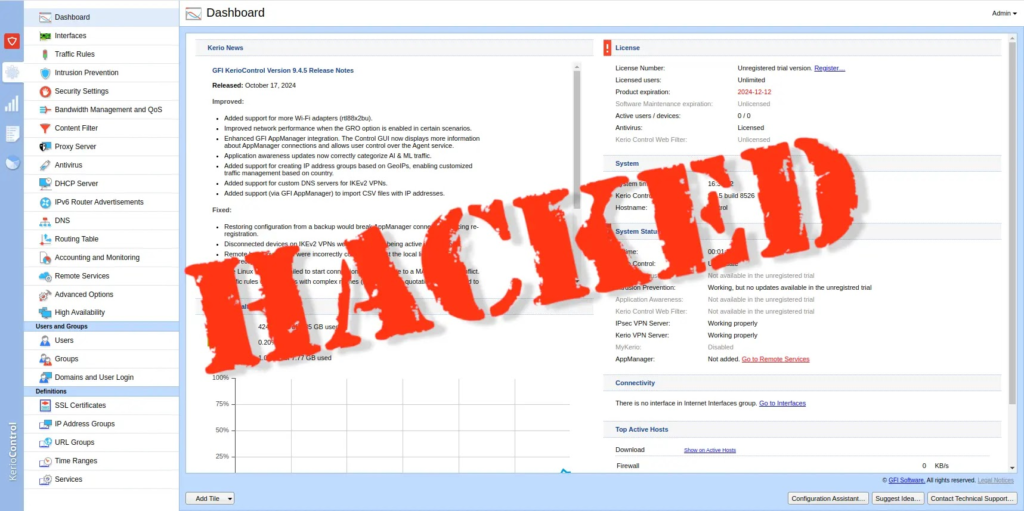Kerio Control Firewall Vulnerability Alert - Protect Your Network

Hoplon InfoSec
09 Jan, 2025
A severe vulnerability has been discovered in Kerio Control, a widely used firewall and Unified Threat Management (UTM) product. This flaw could allow attackers to execute remote code with minimal user interaction, putting thousands of installations worldwide at risk. In this article, we delve into the details of the vulnerability, its potential consequences, and what organizations using Kerio Control can do to protect themselves.
Understanding the Vulnerability: CVE-2024-52875 (Kerio Control Vulnerability)
The vulnerability, CVE-2024-52875, affects Kerio Control versions 9.2.5 through 9.4.5. Security researcher Egidio Romano uncovered multiple HTTP Response Splitting vulnerabilities in the software. These vulnerabilities allow attackers to perform Open Redirect and HTTP Response Splitting attacks, which could lead to more severe issues, such as Reflected Cross-Site Scripting (XSS).
Initially, this flaw was thought to pose a low severity risk due to the user interaction required. However, further analysis revealed that it could be exploited to achieve 1-click Remote Code Execution (RCE) by leveraging a nine-year-old vulnerability. This reclassification raised its severity level to high, with a Common Vulnerability Scoring System (CVSS) score of 8.8.

Kerio Vulnerability
The Potential Impact: A Root Shell Compromise
The implications of this vulnerability are alarming. Successful exploitation could provide attackers with a root shell on the firewall. This level of access would effectively compromise the entire network security infrastructure, as the firewall serves as a frontline defense against cyber threats. Organizations relying on Kerio Control to safeguard their systems may find their defenses ineffective.
A Lack of Mitigation: GFI Software’s Response
GFI Software, the company responsible for Kerio Control, has been notified of the vulnerability. However, as of now, no official patch or mitigation strategy is available. This leaves users and administrators in a precarious position, emphasizing the importance of staying updated on developments and taking precautionary measures to protect their networks.
Technical Details of the Vulnerability

The vulnerability is rooted in several pages of the Kerio Control interface, including:
/non auth/addCertException.cs
/non auth/guestConfirm.cs
/non auth/expiration.cs
The issue arises from improper sanitization of user input passed via the “dest” GET parameter. This unsanitized input generates a “Location” HTTP header in a 302 HTTP response, allowing attackers to manipulate the response and execute malicious actions.
Lessons for Organizations
This incident highlights several critical lessons for organizations, particularly those relying on security-focused products like Kerio Control:
Continuous Security Testing
Even products designed for cybersecurity can harbor vulnerabilities. Continuous testing and auditing of security systems are essential to uncover hidden flaws before they can be exploited.
The Importance of Prompt Patching
The discovery of an exploited nine-year-old vulnerability underscores the need for regular patching and updates. Vendors and organizations must address vulnerabilities promptly to prevent long-term exposure.
Layered Security Measures
Organizations should implement additional security layers while waiting for a vendor patch to mitigate risk. These might include:
Network Segmentation: Limiting the access of the compromised firewall to critical assets.
Endpoint Security Solutions: Adding protection at the endpoint level to detect and respond to threats.
Web Application Firewalls (WAFs): Filtering and monitoring HTTP traffic to prevent attacks.
Immediate Actions for Kerio Control Users
Organizations using Kerio Control should take the following steps to minimize their exposure:
Monitor for Updates: Stay informed about official updates or patches from GFI Software. Regularly check their security advisories and forums.
Review System Logs: Look for unusual activity or signs of potential exploitation. Early detection can prevent further damage.
Restrict Access: Limit access to the Kerio Control interface to trusted IP addresses. Use VPNs for administrative access whenever possible.
Educate Users: Ensure users understand the risks of interacting with untrusted links or files, as user interaction is required to exploit this vulnerability.
Consider Alternatives: Organizations might consider transitioning to alternative solutions that offer equivalent functionality and robust security if a patch is not released promptly.
The Bigger Picture: The Lifespan of Vulnerabilities

This case is a stark reminder of how long vulnerabilities can persist if not adequately addressed. A nine-year-old flaw resurfacing to enable RCE is a testament to the importance of thorough vulnerability management practices. Organizations must:
Audit Legacy Systems: Regularly assess older systems for vulnerabilities that may have been overlooked or inadequately patched.
Collaborate with Vendors: Maintain open communication with software providers to ensure timely fixes.
Invest in Cybersecurity Training: Equip IT teams with the knowledge and skills to identify and mitigate risks effectively.
Moving Forward: Staying Vigilant
As this situation unfolds, IT security teams must remain vigilant. Cyber threats evolve rapidly, and attackers quickly exploit newly discovered vulnerabilities. Proactive measures, such as monitoring threat intelligence feeds and participating in cybersecurity communities, can help organizations stay ahead of potential attacks.
Conclusion
The discovery of CVE-2024-52875 in Kerio Control underscores cybersecurity’s dynamic and challenging nature. While the immediate lack of a patch is concerning, organizations have the tools and strategies to mitigate risks and protect their networks. Businesses can navigate vulnerabilities and strengthen their overall security posture by prioritizing security testing, patch management, and layered defenses.
Kerio Control users must act decisively to secure their systems while awaiting an official fix. The lessons learned from this vulnerability will improve how vendors and organizations address and prevent similar issues.
For more:
https://cybersecuritynews.com/kerio-control-firewall-vulnerability/
Share this :